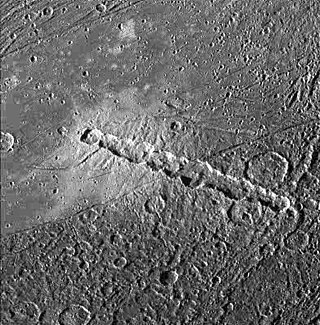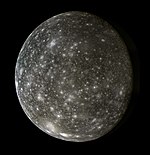
An impact crater is a circular depression in the surface of a solid astronomical body formed by the hypervelocity impact of a smaller object. In contrast to volcanic craters, which result from explosion or internal collapse, impact craters typically have raised rims and floors that are lower in elevation than the surrounding terrain. Impact craters range in size from microscopic craters seen on lunar rocks returned by the Apollo Program to simple bowl-shaped depressions and vast, complex, multi-ringed impact basins. Meteor Crater is a well-known example of a small impact crater on Earth.
In Norse mythology, Útgarðar surrounded a stronghold of the jötnar. They are associated with Útgarða-Loki, a great and devious jotunn featured in one of the myths concerning Thor and the other Loki who competed in rigged competitions held in the Outyards. These outdoor arenas contrasted with the putrid, indoor cave where Útgarða-Loki is said to have dwelt, when chained, in the Gesta Danorum.

Callisto, or Jupiter IV, is the second-largest moon of Jupiter, after Ganymede. In the Solar System it is the third-largest moon after Ganymede and Saturn's largest moon Titan, and as large as the smallest planet Mercury, though only about a third as massive. Callisto is, with a diameter of 4,821 km, roughly a third larger than Earth's Moon and orbits Jupiter on average at a distance of 1,883,000 km, which is about six times further out than the Moon orbiting Earth. It is the outermost of the four large Galilean moons of Jupiter, which were discovered in 1610 with one of the first telescopes, being visible from Earth with common binoculars.

Rhea is the second-largest moon of Saturn and the ninth-largest moon in the Solar System, with a surface area that is comparable to the area of Australia. It is the smallest body in the Solar System for which precise measurements have confirmed a shape consistent with hydrostatic equilibrium. It was discovered in 1672 by Giovanni Domenico Cassini.

Tindr is a crater on Jupiter's moon Callisto. It is named after one of the ancestors of Ottar in Norse mythology. This is an example of a central pit impact crater.

Hár is a crater on Jupiter's moon Callisto. Its name is one of the many names of Odin, the supreme god in Norse mythology. This is an example of a central dome impact crater.

Located on Jupiter's moon Callisto, Valhalla is the largest multi-ring impact crater in the Solar System. It is named after Valhalla, the hall where warriors are taken after death in Norse mythology.

A crater chain is a line of craters along the surface of an astronomical body. The descriptor term for crater chains is catena, plural catenae, as specified by the International Astronomical Union's rules on planetary nomenclature.

Cleopatra, initially called Cleopatra Patera, is an impact crater on Venus, in Maxwell Montes.

Adlinda is the third-largest multiring structure on Jupiter's moon Callisto, measuring ~ 1000 km in diameter. It is situated in the southern hemisphere of Callisto. The name is taken from Inuit mythology.

Gomul Catena is a chain of craters on Jupiter's moon, Callisto. It is situated in the northern part of Valhalla multi-ring structure. The craters in the catena seem to have formed from east to west. Such features are thought to originate as secondary craters or due to fragmentation of the impactor.

Arcas is a crater on Jupiter's moon Callisto measuring 60 km (37 mi) across. It is an example of a central pit impact crater. A smaller crater near Arcas is called Ginandi. The crater is named after Arcas, the son of Callisto in Greek mythology.

Lofn is a large relatively young impact crater on Jupiter's Galilean satellite Callisto. It was identified in 1997 and named after the goddess of marriage in Norse mythology. Located near the south pole of this moon, Lofn is classified as a flat floored or anomalous dome impact crater. It is superimposed on Adlinda multilayer structure obscuring about 30 percent of it. Another multi-ring structure—Heimdall is found to the south-west of Lofn.

Complex craters are a type of large impact crater morphology.

Menrva is the largest crater on Titan, with a diameter of 392 kilometers. The crater is a heavily eroded double ringed impact basin, similar to the impact related features of Mars and Mercury. This is evident by Menrva's distinct lack of a central peak, indicating modification of the crater's surface since formation. It has been estimated that Menrva is approximately 2.8 kilometers deep.

A multi-ringed basin is not a simple bowl-shaped crater, or a peak ring crater, but one containing multiple concentric topographic rings; a multi-ringed basin could be described as a massive impact crater, surrounded by circular chains of mountains resembling rings on a bull's-eye. A multi-ringed basin may have an area of many thousands of square kilometres.
![<span class="mw-page-title-main">Heimdall (Callistoan crater)</span> Crater on [[Callisto (moon)|Callisto]]](https://upload.wikimedia.org/wikipedia/commons/thumb/9/96/Callisto_USGS_global_small.jpg/320px-Callisto_USGS_global_small.jpg)
Heimdall is one of the largest known impact craters on Jupiter's Galilean satellite Callisto, with a diameter of 210 km. It is located near the Callistoan south pole at 63.5°S 3°E. It was firstly suspected on Voyager images, and later confirmed by Galileo.
















![<span class="mw-page-title-main">Heimdall (Callistoan crater)</span> Crater on [[Callisto (moon)|Callisto]]](https://upload.wikimedia.org/wikipedia/commons/thumb/9/96/Callisto_USGS_global_small.jpg/320px-Callisto_USGS_global_small.jpg)
